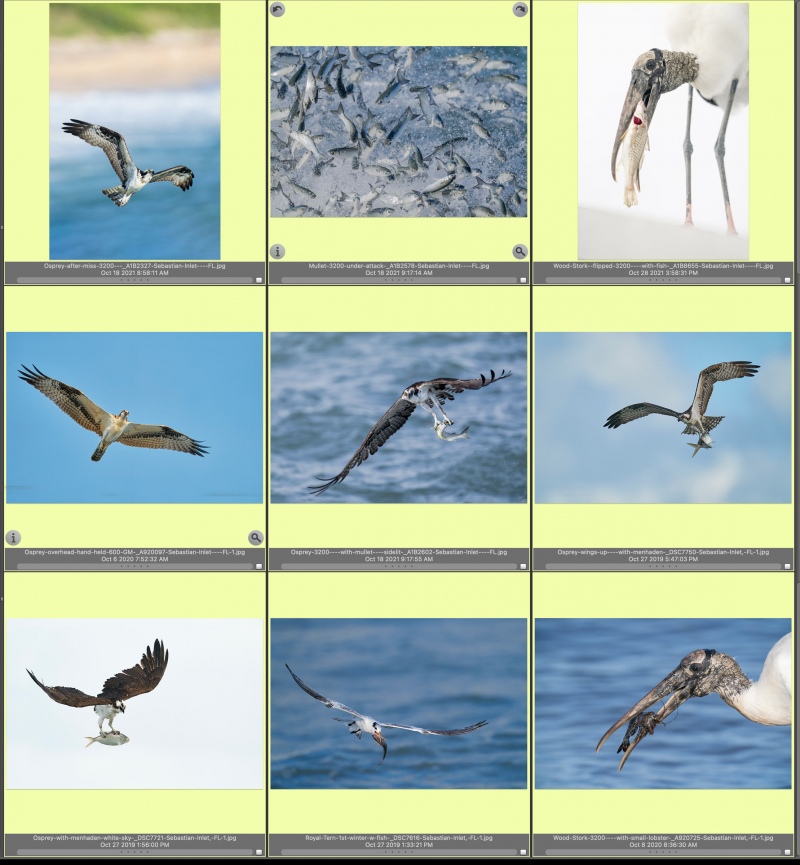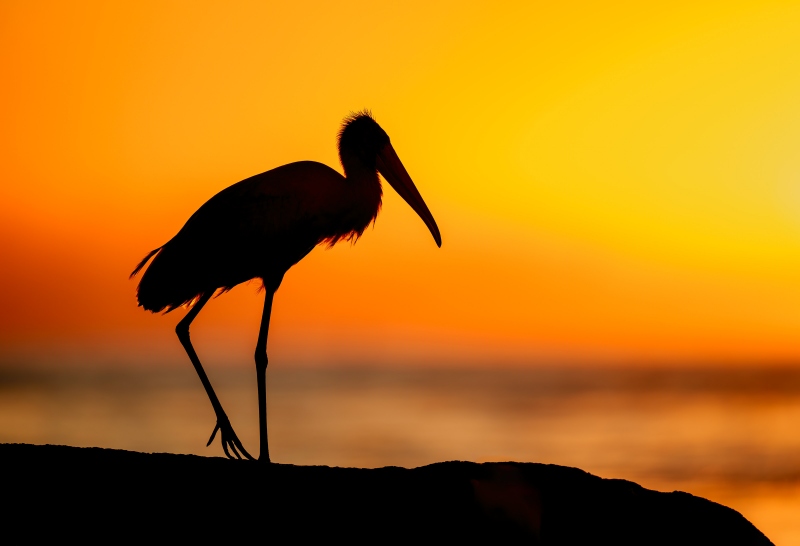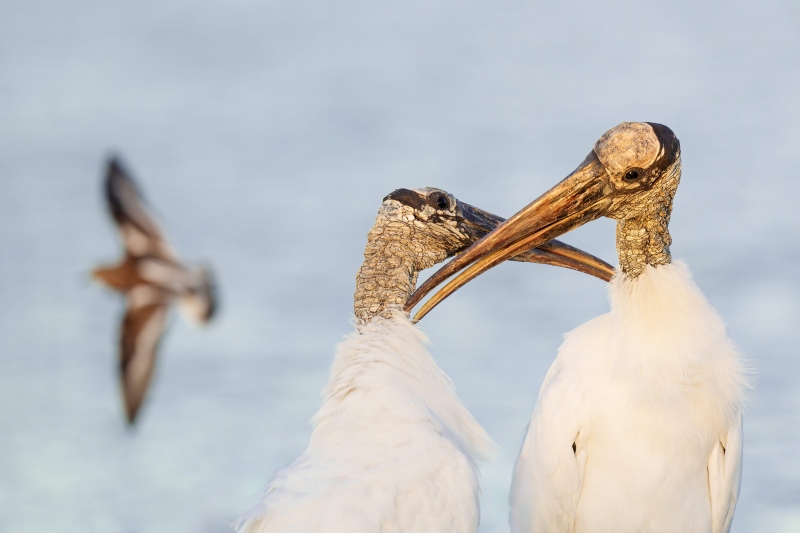A Bird Photographers Story
At 7pm eastern time today, Monday 23 October 2023, I will be presenting a free online webinar for the Delaware Photographic Society. It is free to all with a good connection. At 6:59pm, click here and then click on the Free Webinar photo/icon and you should be able to figure out how to get in. No registration is needed.
Nikon NIKKOR Z 800mm f/6.3 VR S Lens
Stan Gorlitsky is offering a Nikon NIKKOR Z 800mm f/6.3 VR S lens in mint condition for a very low $5,496.95. The sale includes a ROLANPRO Waterproof Lens Camouflage Coat for Nikon Z 800mm f6.3 VR S (a $110.00 value), the original box, the front and rear lens caps, the lens case, 3 1/2 years on the transferable New Leaf warranty, and insured ground shipping via major courier.
Please contact Stan via e-mail or by phone at 843-224-1367 (Eastern time zone).
All the Reach, Half the Weight
When I used Canon gear, I always loved the 800mm focal length for birds. At 5.25 pounds, this lens weighs more than a pound less than the Sony 600mm f/4 GM. I am impressed. I ran into two folks at Sebastian this morning using the 800 Z; they both love it. This lens sells new right now for $6,496.95. Grab Stan’s as-good-as-new copy and save $1000.00.”
Huge focal length, compact and lightweight design. The NIKKOR Z 800mm f/6.3 VR S, from Nikon, is a super-telephoto prime distinguished by the unique combination of one of the longest focal lengths available in a surprisingly portable package. This distinct design is made possible by the inclusion of a Phase Fresnel element, which cuts the overall weight by 50% and the length by 16% compared to the former F-mount 800mm f/5.6 lens. B&H
|
|
|
Clockwise from the upper left back around to center: Osprey gaining altitude after missed strike; school of mullet under attack from below; Wood Stork with Southern Whiting; Osprey with Menhaden; Wood Stork with small lobster; Royal Tern with large baitfish; Osprey with Menhaden; juvenile Osprey directly overhead “t-shot”; Osprey taking flight with freshly caught Mullet. |
Sebastian Inlet In-the-Field Sessions
Act Now!
Share a great AirBnB 10 minutes from Sebastian Inlet with me this week only!
Join me for 3 hours of morning In-the-Field Instruction at Sebastian Inlet for only $300.00/session. The main target will be Ospreys fishing for a variety of migrating saltwater fish that visit the inlet each fall. Back-up subjects include fishing gulls, terns, and Brown Pelicans, Wood Stork, a variety of herons and egrets, shorebirds in the afternoon, sunrise cloud-scapes, and the occasional sea turtle or manatee.
October Dates: 24-29, 2023.
November Dates: 6-10, 2023.
Please get in touch via e-mail to book one or more sessions.
Your Call?
Which of today’s Wood Stork images do you like best? Why?
My Call
My favorite images from the last blog post were #2 — I love the arrangement of the eight birds, the soft light, and the breaking wave, #3, for the soft light, the wings up flight pose, and the greenish water, and #4 with the lovely breeding plumage full adult and the wings slightly down flight pose.
As for the d-o-f question with #1, yes, the bird was flying low against the water and that brought up too much background detail for me. What everyone missed was that I was zoomed out to 347mm; with the subject the same size in the frame, shorter focal lengths will always result in more d-o-f than you would get with a longer focal length. The bird, of course, would need to be farther away.
In #2, all of the birds were rendered relatively sharp on the face even though they were not on the exact same plane because of the relatively great focusing distance. As the distance increase, d-of increases dramatically. Note: when working at 840mm at minimum focusing distance, d-o-f is measured in small fractions of an inch, or about 1cm. At the actual focusing distance, 454 meters, d-o-f works out to be more than 100 meters!
What’s Up?
Before the sun came up on Friday and Saturday morning at Sebastian Inlet, there were about 3 dozen Ospreys diving for fish in a small cove. The bad news is that there was a kiss of death wind from the NW. But with the low tide, there were dozens of Wood Storks, herons and egrets, pelicans, cormorants, and several species of shorebirds. I got some fabulous stuff on Wood Stork including some superb flight shots and my four best Reddish Egret action photos. The best news: the wind is shifting to the east/northeast for the rest of the week.
Today is Monday 23 October 2023. I will be doing lots of relaxing and getting ready for tonight’s webinar. I hope to see you there, at least virtually.
Wherever you are an whatever you are doing, I hope that you too have a great day.
Please remember to use the B&H and Amazon links that are found on most blog pages and to use the BIRDSASART discount code at checkout when purchasing your new gear from Bedfords to get 3% back on your credit card and enjoy free second-day air FedEx. Please, also, consider joining a BAA IPT. You will be amazed at how much you will learn!
You can find some great photo accessories (and necessities, like surf booties!) on Amazon by clicking on the Stuff tab on the orange/yellow menu bar above. On a related note, it would be extremely helpful if blog-folks who, like me, spend too much money on Amazon, would get in the habit of clicking on the Amazon logo link on the right side of each blog post when they shop online. As you might expect, doing so will not cost you a single penny, but would be appreciated tremendously by yours truly. And doing so works seamlessly with your Amazon Prime account.
If an item — a Delkin flash card, or a tripod head — for example, that is available from B&H and/or Bedfords, is also available in the BAA Online Store, it would be great, and greatly appreciated, if you would opt to purchase from us. We will match any price. Please remember also to use my B&H affiliate links or to earn 3% cash back at Bedfords by using the BIRDSASART discount code at checkout for your major gear purchases. Doing either often earns you free guides and/or discounts. And always earns my great appreciation.
B&H Simplified
To ensure that I get credit for your B&H purchases, you can always click here. The tracking is invisible but greatly appreciated. And, you can use your PayBoo card. You must use the website to order. B&H will reopen on Fri April 14. Thanking me for the past 4000 educational blog posts could not be any easier and will not cost you one penny. Please shoot me your B&H receipt for major purchases.
Bedfords Simplified
Click here to start your search. Choose standard shipping, and when you get to the payment page, enter BIRDSASART in the discount code box and hit apply. You will be upgraded to free second day air Fed-Ex and receive 3% cash back on your credit card once your stuff ships. Either is greatly appreciated by yours truly.
B&H
Many folks have written recently stating that they purchased a Sony a1 from B&H and would like their free membership in the Sony 1 Info and Updates Group, a $150.00 value. When I check my affiliate account, their orders have not been there. When I let them know that they get credit for B&H purchases only if they use one of the many B&H affiliate links on the blog or begin their searches with this link, they are always disappointed. If in doubt, please contact me via e-mail and request a BH link. I am always glad to help and to guide you to the right gear.
Bedfords Amazing BAA Discount Policy
Folks who have fallen in love with Bedfords can now use the BIRDSASART coupon code at checkout to enjoy a post-purchase, 3% off-statement credit (excluding taxes and shipping charges) on orders paid with a credit card. The 3% credit will be refunded to the card you used for your purchase. Be sure, also, to check the box for free shipping to enjoy free Second Day Air Fed-Ex. This offer does not apply to purchases of Classes, Gift Cards, prior purchases.
Visit the Bedfords website here, shoot Steve Elkins an e-mail, or text him on his cell phone at (479) 381-2592.
Important Note
As an Amazon Associate, I earn a small percentage when you purchase from Amazon after using any of the Amazon links on the blog (including the logo-link on the right side of each blog post page). My affiliate link works fine with Amazon Prime and using it will not cost you a single cent. Huge thanks, BTW 🙂


Gear Questions and Advice
Too many folks attending BAA IPTs and dozens of photographers whom I see in the field and on BPN, are — out of ignorance — using the wrong gear, especially when it comes to tripods and more especially, tripod heads. And the same is true in spades when ordering new camera bodies or lenses. My advice will often save you some serious money and may help you avoid making a seriously bad choice. Please know that I am always glad to answer your gear questions via e-mail. If you are desperate, you can try me on my cell at 863-221-2372. Please leave a message and shoot me a text if I do not pick up.
|
|
|
This image was created on 21 October at Sebastian Inlet State Park 18 miles north of Vero Beach, FL. Crouching quite a bit, I used the handheld Sony FE 400mm f/2.8 GM OSS lens and The One, the Sony Alpha 1 Mirrorless Digital Camera). The exposure was determined via Zebra technology with ISO on the Thumb Dial. ISO 500. 1/2500 sec. at f/2.8 (wide open) in Manual mode. When evaluated in RawDigger, the raw file brightness was determined to be dead-solid perfect (ho hum). AWB at 7:32:36am , six minutes after sunrise. Tracking: Expand Spot/AF-C with Bird Face/Eye detection enabled performed to perfection. Be sure to click on the image to enjoy a larger, sharper high-res version. Image #1: Wood Stork sunrise silhouette |
Right Place; Right Time. Seeing the Shot
On Friday morning, I was delayed about ten minutes while getting my annual Florida State Park pass. I thought that the birds filling the sky were gulls, but when I checked them out more carefully, saw that they were Ospreys! So, I headed over the bridge, parked, and walked down to the beach with the 400mm f/2.8. Looking back to the east, I saw a low line of clouds on the horizon. “Could be nice,” I thought. With wind against sun conditions, always think silhouettes. As the sun brushed the top of the clouds, all I needed was a bird in the right spot. At just the right moment, a Wood Stork landed on the perfect rock. It only stayed for a few seconds but after setting a good exposure, I was a very happy man.
There were as many photographers on the beach as there were Ospreys in the sky, yet nobody saw the winning shot but me. What else is new.
Learn to see the shot by joining any IPT.
Why Crouching?
Why was crouching vitally important to the artistic success of Image #1?
|
|
|
This image was also created on 21 October at Sebastian Inlet State Park 18 miles north of Vero Beach, FL. Seated on damp mud, I used the knee-pod technique with the handheld Sony FE 400mm f/2.8 GM OSS lens and The One, the Sony Alpha 1 Mirrorless Digital Camera). The exposure was determined via Zebra technology with ISO on the Thumb Dial. ISO 2500. 1/2000 sec. at f/4 (stopped down 21-stop) in Manual mode. When evaluated in RawDigger, the raw file brightness was determined to be dead-solid perfect (ho hum). AWB at 7:44:48am on clear sunny morning. Tracking: Spot S AF-C with Bird Face/Eye detection enabled performed to perfection. Be sure to click on the image to enjoy a high-res version. Image #2: Wood Storks allo-preening with fly-by Ruddy Turnstone |
Right Place; Right Time. Seeing the Shot, Again
After the early morning Osprey feeding spree, I concentrated on the Wood Storks in the sweet, gorgeous butter light. I was lucky when two Wood Storks began preening each other right in front of me and right down sun angle. Most of the 20-odd photographers did not show much if any interest in the storks. The guy next to me did make a few frames before moving on to something else. I was thrilled to get a clean shot at photographing this not very common behavior. I do have a very few frames of allopreening Black Vultures, but nothing to write home about.
As there would be two bird heads in the frame, I stopped down one stop. When there are two subjects, I almost always want to focus on the closest bird. I was using Tracking; Zone and for the most part, the AF tracked the eye of the nearest bird, the stork on my right. But at the penultimate moment, it grabbed the eye of the left-hand bird 🙁 Actually, this was 100% operator error; I should have switched to Tracking: Expand Spot and turned off Eye Priority AF. With my set-up, that can be done in about one second by pressing two specific buttons. That would have kept focus on the eye of the right hand (also the “right”) bird.
As expected in this situation, the face and head of the right hand bird was not in sharp focus as it was in front of the plane of focus. Topaz Sharpen AI did a decent job that wound up being fine for web presentation. But it surely would not stand up to close scrutiny on a pill level. For Arash Hazeghi, it would have been an insta-delete. How does it look to you?
Getting Lucky
When I saw the out of focus, vertical banking Ruddy Turnstone in just the right spot in the frame, I thought, “I couldn’t have painted that bird in any better!”
Allopreening
Adapted from the Wikipedia article on preening here.
Although preening (feather maintenance) is primarily an individual behavior, some bird species indulge in allopreening where one individual preens another. It is not common in most bird species, but birds from at least 43 families are known to engage in this mutual activity. Most allopreening activity concentrates on the head and neck area, a lesser amount being directed towards the breast and mantle and an even smaller percentage applied to the flanks. A few species are known to allopreen other areas, including the rump, tail, belly and underwing.
Several hypotheses have been advanced to explain the behavior: that it assists in effective grooming, that it assists in recognition of individuals (mates or potential sexual partners), and that it assists in social communication, reducing or redirecting potential aggressive tendencies. These functions are not mutually exclusive. Evidence suggests that different species may participate for different reasons, and that those reasons may change depending on the season and the individuals involved. In most cases, allopreening involves members of the same species, although some cases of interspecific allopreening are known; the vast majority of these involve icterids, though at least one instance of mutual grooming between a free and wild Black Vulture and a free and wild Crested Caracara has been documented.
Typos
With all blog posts, feel free to e-mail or to leave a comment regarding any typos or errors.


















Artie,
#1 the colors are great and the drop off of the rock on the right side makes the image more powerful by having the orange at bottom of the frame. It appears you were slightly lower than the stork.
Image #1 Wood Stork is dark and hard to see the bird! Image #2 Wood Storks is well made and interesting of the two birds! And the other image of 8 birds and a photo of a bunch of birds flying is interesting!
Re #1: you crouched in order to place the bird’s entire body, plus some leg, above the horizon line.